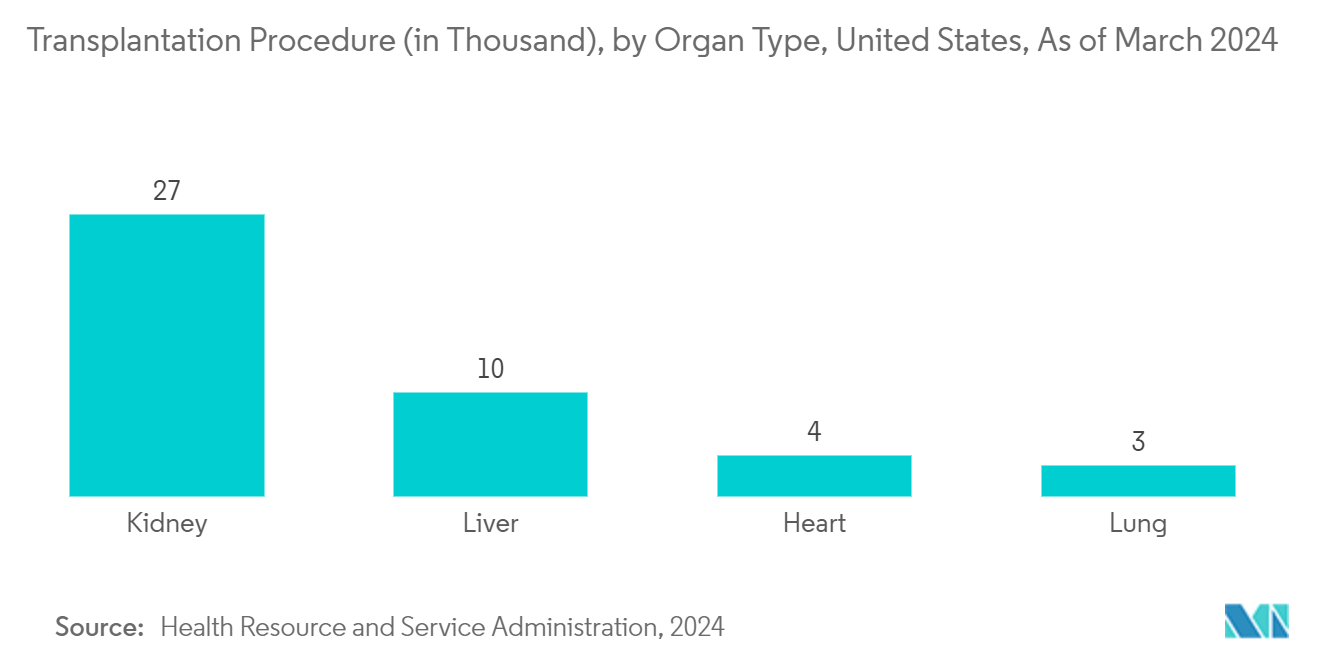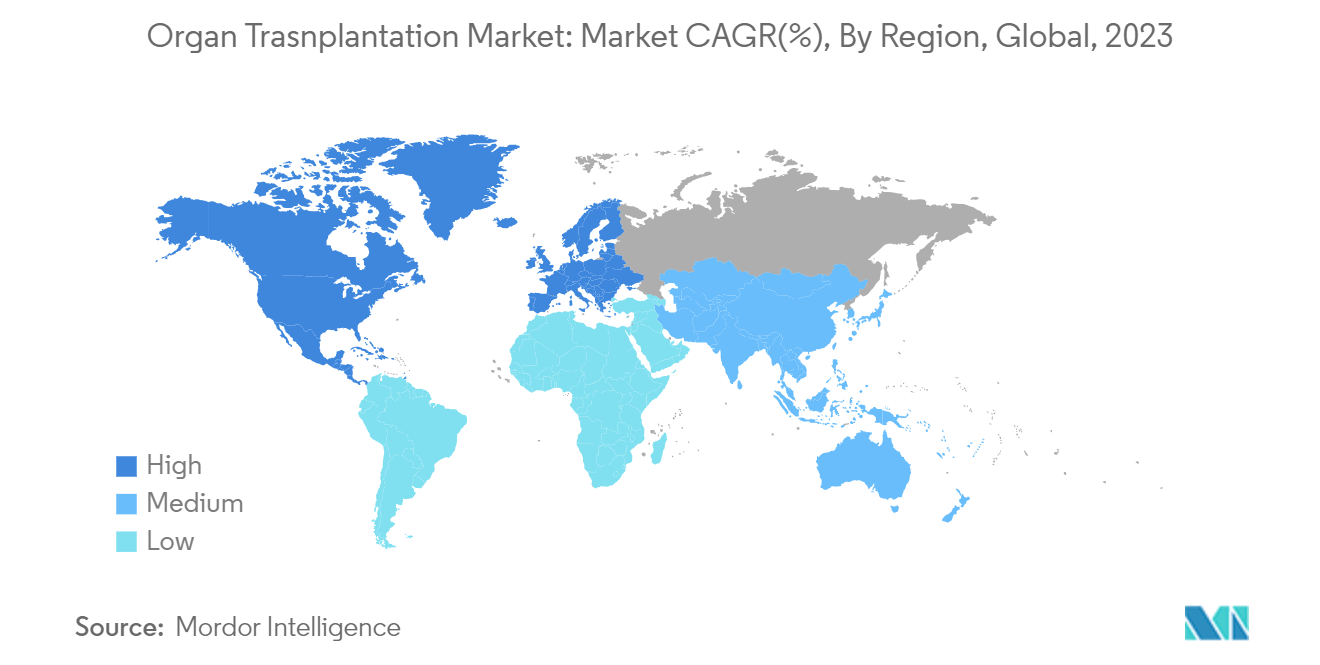Market Trends of Organ Transplantation Industry
Immunosuppressant Drugs Segment Expected to Witness Significant Growth Over the Forecast Period
Immunosuppressant drugs play a crucial role in organ transplantation, safeguarding the transplanted organ from rejection by the recipient's immune system. Key categories of these drugs include calcineurin inhibitors, antiproliferative agents, mTOR inhibitors, monoclonal antibodies, and corticosteroids. Segment growth is anticipated due to factors like the increasing number of organ transplants, heightened organ rejection risks, advancements in immunosuppressant therapies, and ongoing research and development activities into novel and combination immunosuppressant drugs.
Calcineurin inhibitors (CNIs) are foundational to renal transplant immunosuppression. Cyclosporine A (CSA) and tacrolimus (TAC), the two primary CNIs, have been integral for kidney transplant recipients for over two decades. Numerous studies have assessed the safety and efficacy of these drugs in organ transplants. For instance, a November 2023 article published in the National Library of Medicine highlighted that cyclosporine, an FDA-approved adjuvant, effectively prevents allogenic organ transplant rejection when combined with glucocorticoids. This finding has been especially relevant for patients undergoing kidney, heart, liver, and bone marrow transplants. Given the proven efficacy of calcineurin inhibitors in organ transplant patients, their prominence in the market is set to grow.
Additionally, researchers are actively developing novel immunosuppressant drugs, further driving their demand in organ transplantation and fueling the segment’s growth. For instance, in August 2023, Duke Health researchers reported that AT-1501, a synthetic monoclonal antibody, successfully prevented organ rejection in primate kidney transplant tests. Notably, this was achieved without needing extra immunosuppressive drugs or causing blood clots. The findings endorsed AT-1501 as both safe and effective for enhancing islet and kidney transplant survival and function. Such breakthroughs are likely to accelerate the market introduction of new immunosuppressant drugs.
Furthermore, the rise of monoclonal antibodies and immune-targeting drugs could amplify the demand for immunosuppressants in organ transplants. For instance, in March 2024, Eledon Pharmaceuticals Inc. highlighted the use of tegoprubart, an experimental anti-CD40L antibody, in the groundbreaking transplant of a kidney from a genetically modified pig to a human. Multiple studies have validated tegoprubart's safety and tolerability, especially in preventing kidney transplant rejection. Such developments are expected to spur market growth over the forecast period.
Therefore, owing to factors such as the rising number of research studies related to the safety and effectiveness of immunosuppressant drugs in organ transplantation and new product launches by key players, the segment studied is expected to grow over the forecast period.

North America Expected to Hold a Significant Market Share Over the Forecast Period
North America is poised for substantial growth during the forecast period, driven by a surge in transplant procedures, a rising prevalence of chronic conditions necessitating organ transplants, and the region's supportive reimbursement policies. Furthermore, bolstered by heightened government investments, proactive initiatives, and new product introductions by major players, the market is set to expand over the forecast period.
The prevalence of kidney-related health conditions has surged over recent years. As conditions like kidney failure and end-stage renal diseases become more common, the demand for kidney transplantation procedures rises, subsequently boosting the market for related products. For instance, a modeling analysis published by AstraZeneca in April 2024 highlighted that approximately 16.5% of the population in eight countries, including the United States, totaling 125 million people, are projected to be affected by chronic kidney disease (CKD). This marks a 25% increase since 2022, with advanced-stage cases potentially escalating by nearly 60% by 2032. Such numbers emphasize the growing burden of kidney diseases and the increasing need for kidney transplants, hence driving market expansion.
The rising number of organ transplantation procedures is set to drive market growth during the forecast period. For instance, data released by the Health Resources and Services Administration in January 2024 revealed that the United States witnessed approximately 46,632 organ transplants from both living and deceased donors in 2023. This marked an 8.7% increase over 2022.
In addition to the above, out of the total 46,632, 39,679 organ transplants were sourced from deceased donors in the United States in 2023, reflecting an 8.9% increase over the previous year. Consequently, as organ transplantation procedures become more prevalent, there is a burgeoning demand for organ preservation, diagnostics, and immunosuppressant drugs, which is anticipated to fuel market growth.
Furthermore, government initiatives, including investments in organ transplantation and procurement programs, as well as efforts to raise awareness about organ transplantation procedures, are poised to drive market growth in the coming years. For instance, in March 2023, the US Department of Health and Human Services invested about USD 36 million for organ procurement and transplantation, bringing the total to USD 67 million for Fiscal Year 2023. Similarly, in February 2024, Health Canada collaborated with the Organ Donation and Transplantation Network to enhance organ and tissue donation and transplantation efforts. These initiatives are anticipated to boost the demand for organ and tissue donations, subsequently elevating the need for organ preservation solutions, transplantation products, diagnostic devices, and related drugs in the market.
Additionally, as companies ramp up organ transplantation procedures and introduce related products, the market is set for growth. For instance, in April 2024, United Therapeutics Corporation achieved a milestone by transplanting its produced UThymoKidney into a living recipient. This transplant was authorized by the Food and Drug Administration under the expanded access pathway. The UThymoKidney is a pioneering investigational xenokidney derived from a pig, featuring a single genetic edit and supplemented with tissue from the pig’s thymus.
In February 2024, Bridge to Life Ltd reintroduced its organ preservation solution, EasiSlush, in the United States. EasiSlush's user-friendliness and efficiency position it as a crucial asset for healthcare professionals, emphasizing its role in saving lives. Such advancements are set to amplify demand for organ preservation products, propelling market growth.
Therefore, owing to the growing burden of kidney-related health conditions, increasing number of organ transplant procedures, growing government investments and initiatives to promote organ and tissue donation and transplantation procedures, and rising organ transplant procedures, coupled with new product launches by key players, the market studied is expected to grow over the forecast period.


